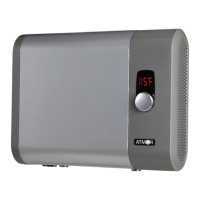8
• The maximum operating water pressure for this unit is 150PSI / 10BAR. Residential plumbing systems with
unstable pressure or pressure above 5 BAR require the application of a pressure reduction valve set to 4-5 BAR
for optimal performance.
• The water supply ow rate must be at least 0.5 Gallons per Minute (GPM) to ensure proper operation.
• Flexible water hoses are recommended to be used with your water heater when installing your water heater.
When connecting the inlet water pipe to the unit, use a wrench to hold the unit’s connection, and another wrench
to tighten so that the ow sensor on the unit will not be loosened or damaged. Do not over-tighten the water inlet
and outlet connections to avoid severe internal damage to the water heater.
• We recommend the installation of a manual shut-o valve (ball valve) on the inlet and outlet of the water heater
to create a convenient shut-o point if future maintenance or servicing is required. Before connecting the pipes
to the water heater, it is highly essential to ush the lines to eliminate all the plumbing paste or residue in the lines
caused by any welding or soldering.
• All the water pipes within 3 feet (1 meter) of the inlet and outlet connections are recommended to be rated for
high-temperature applications with 150°F (66°C) minimum.
• Before proceeding to the electrical installation, run water through the unit for several minutes to ush out any air
bubbles from the water line.
6. Plumbing Installation
STEP 1: Thoroughly ush cold supply line of debris.
STEP 2: Connect the HOT WATER line to the water heater OUTLET. The water heater outlet can be seen on the left
side of the heater when facing the unit. Connect the COLD-WATER line to the water heater marked COLD WATER
INLET which is located on the right side when facing the unit.
* Pre-heated water can be connected to the cold water inlet, where this unit will act as a booster.STEP 3: After
tightening both ttings at the water heater, several hot water faucets should be opened to allow the ow of water
through the water heater for at least 2 to 3 minutes. This process purges all the air from the water lines and MUST be
performed before turning on the power at the unit.
FAILURE TO FOLLOW THIS STEP MIGHT CAUSE PERMANENT DAMAGE TO THE HEATING ELEMENTS. (The
power to the heater should be turned o and the air purged out of the lines before turning the power on anytime
maintenance is performed on the water heater or the homes plumbing system, as air might have been introduced into
the plumbing pipes.)
STEP 4: Carefully inspect all connections, units, and the pressure relief device for leaks after the plumbing installation
is completed. If there are no leaks present, you can proceed to the electrical installation.
CAUTION: If you detect a water leak from the water heater at this point, turn o the water supply at the shut o
valve on the unit’s incoming water supply and contact us at 1-844-783-6082.
Plumbing Specications
Minimum water ow to activate the unit 0.5 gpm
Working pressure 0.5–10 BAR (7–150 psi)
Tested pressure (maximum) 20 BAR (290 psi)
Water connections 18kW 1/2” NPT
Water connections 24, 29, 36kW 3/4” NPT

